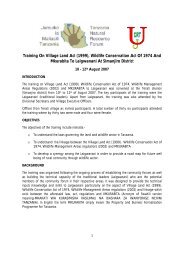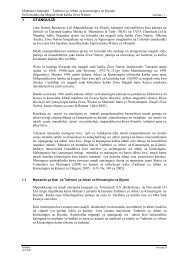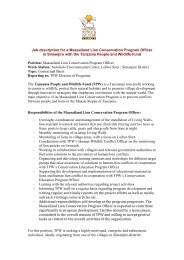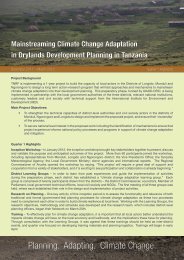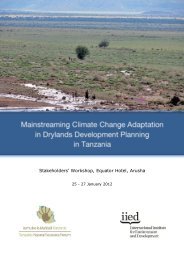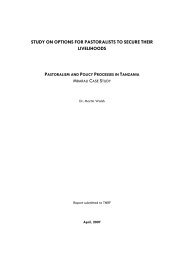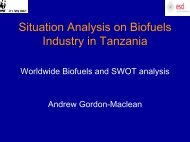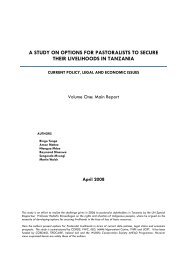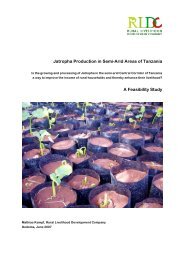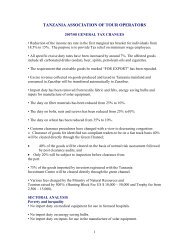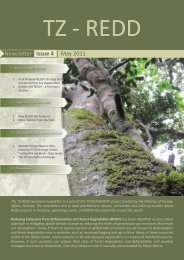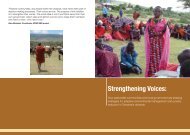DISPATCHES ON ADAPTATION
Dispatches_on_Adaptation - Tanzania Natural Resource Forum ...
Dispatches_on_Adaptation - Tanzania Natural Resource Forum ...
- No tags were found...
Create successful ePaper yourself
Turn your PDF publications into a flip-book with our unique Google optimized e-Paper software.
C<strong>ON</strong>FLICT AND WATER: NORTHERN KENYA<br />
Prepared by Lucy K. Wambugu<br />
Northern Kenya is one of the driest regions in the country. The general<br />
scarcity of water is caused mainly by the geographic location. It<br />
borders the dry zones that are adjacent to the horn of Africa with very<br />
little rainfall, less than 500mm per year, and no natural rivers. The<br />
only river of any mention is the River Tana which only traverses the<br />
southern part of the area on its way to the Indian ocean. Its volume<br />
is affected by both hydro electric and agricultural activities. These<br />
activities have reduced the water that finds its way to the region and<br />
also the quality due to contamination with agricultural and industrial<br />
chemicals and waste up stream.<br />
The weather has become more unpredictable with time. Normally<br />
Northern Kenya expects two rain seasons per year. Lately the trend<br />
has become alarming since the rain seasons have become shorter<br />
and there have even been periods with no rains or very little rains for<br />
periods of up to three years. The region also experiences extreme<br />
temperatures up to 40 degrees Celsius. This makes it a very difficult<br />
area to live in and it also means that the vegetation cover is reduced<br />
to scrubland. Except for a few pockets like the area around Marsabilt<br />
which has a relatively more normal weather conditions the rest of the<br />
region experiences very harsh climatic conditions and are getting<br />
worse as climate change is effecting the predictability and reliability<br />
of the rains.<br />
The region, which stretches from the Somali border to the Uganda<br />
border to the west and to the Etiopian border to the north is inhabited<br />
by several tribes, mainly pastoralists. These tribes include the Somali,<br />
the Turkana, the Borana, the Rendile, and the Samburu among others.<br />
Traditionally these tribes have very emotional attachment to their<br />
animals and migrate all over the region in search of water and pasture<br />
for their animals. Yet they have their traditionally recognized land of<br />
habitation. Consequently there are occasional incursions of one tribe<br />
into another tribe’s territory in search of water and pasture. When<br />
that occurs there is conflict which arises due to competition over<br />
scarce supply of resources. These tribes have traditionally stolen<br />
cattle from each other and therefore such migration also results in<br />
heightened incidences of conflict.<br />
Small tribal wars due to cattle rustling keep on recurring in the Turkana<br />
and West Pokot Districts and have resulted in the deaths of up to 50<br />
people. Herd boys are killed and abducted together with their animals<br />
(up to 3000 animals could be driven away at one go). This is followed<br />
by retaliations and vengeance such as the event in 2008 in the Turbi<br />
village in Marsabit district where a whole village of 200 persons were<br />
wiped out. However, the most important source of conflict arises from<br />
the competition for scarce resources. There are major conflicts at the<br />
Mbalambala border between the Orma of Tana River and the Somali<br />
of Garissa since the area has traditional water wells whose ownership<br />
keeps on changing hands between the Orma and the Somali depending<br />
on who wins the battle. Here there is competition for water and the<br />
pasture surrounding the wells. Now, due to the ever increasingly<br />
unpredictable weather conditions caused by climate change, water<br />
is becoming even more scarce and is causing even worse competition.<br />
It is expected that these conflicts will escalate and become more<br />
dangerous since the tribes have started to arm themselves with<br />
modern weapons.<br />
The conflicts arising from climate change are not confined to the<br />
Northern region alone and are to be found elsewhere. In the Tana<br />
Delta district, where the Tana River meets the Indian Ocean there are<br />
wetlands which are very conducive for agriculture, inhabited by the<br />
Pokomo. Their neighbours to the north are the Orma who are<br />
pastoralists with large herds of cattle. Whenever there is a prolonged<br />
drought the Orma migrate with their animals towards the wetlands<br />
and graze on anything that is available. Crops are destroyed and the<br />
river is contaminated. The Pokomo whose crops and whose source<br />
of water is being destroyed have always reacted violently and there<br />
have been very serious battles.<br />
The government has realized the issue of resource use and has<br />
embarked on a programme to manage the situation and minimize the<br />
occurrence of these conflicts. A Ministry of Northern Kenya has been<br />
established to oversee the implementation of water provision and the<br />
introduction of changes in land use and the use of natural resources.<br />
These changes together with mobilisation, education and awareness<br />
amongst the people in these areas are expected to reduce these<br />
conflicts and promote co-existence despite the negative effects of<br />
climate change.<br />
The armed conflicts due to water shortage in Northern Kenya and in<br />
particular around the Tana River delta threaten the economic and<br />
political stability of Kenya. As long as the country has developed cold<br />
feet in addressing the causes of armed conflict, it will not escape the<br />
view that it is providing a safe haven for people with criminal intent<br />
who are using water scarcity as a reason for armed conflict. It has<br />
the legal and constitutional mandate to act decisively in order to<br />
protect the lives and property of its nationals. There is a need for the<br />
government to facilitate and support community driven initiatives for<br />
conflicts arising from water shortage especially those that have their<br />
roots in historical social issues. It needs to use the social, economic<br />
and political causes of conflict as pillars to drive and anchor<br />
reconciliation and stability. The government needs to rethink and<br />
redefine its development agenda for the country and its people.<br />
5



